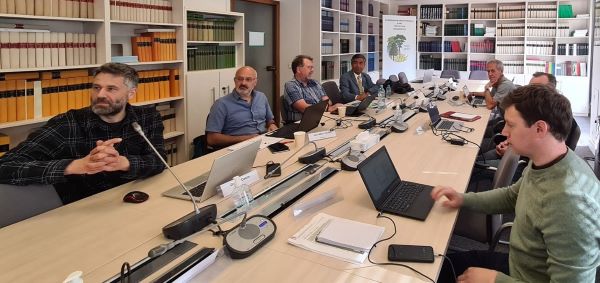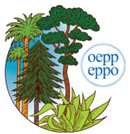
Expert Working Group for Pest Risk Analysis
for the bark beetle Pseudips mexicanus
Paris, 2025-05-13/16
In 2024, the Working Party on Phytosanitary Measures recommended that an Expert Working Group (EWG) should be organized to prepare a Pest Risk Analysis (PRA) for the bark beetle Pseudips mexicanus (Coleoptera: Curculionidae: Scolytinae; IPSXRA; EPPO Alert List).
The EWG met at the EPPO headquarters in May 2025 to carry out this PRA for the EPPO region. Pseudips mexicanus is a bark beetle known to infest pine species (Pinus spp.). Until 2023, it was only known to occur in Mexico and Guatemala. However, in 2023, the species was detected for the first time in the EPPO region, with 93 specimens found in traps placed in conifer plantations in County Clare on the west coast of Ireland.

In its native range, P. mexicanus usually completes its life cycle in pine material that is dying or died recently. It commonly colonizes pine debris resulting from wildfires, lightning, storms, pest damage, or logging. While this beetle is generally considered a secondary pest, there have been reports of its attacks on stressed pine saplings. The exact pathway of its introduction into Ireland remains unknown, although wood packaging material is suspected.
The EWG included eight experts from seven countries (Belgium, Ireland, Mexico, the Netherlands, Spain, Sweden, and the USA), with an additional expert from Finland conducting climatic analyses and preparing distribution maps remotely. The group comprised specialists from the native range of the pest (Mexico), the EPPO country where eradication measures are currently being implemented (Ireland), as well as experts in bark beetle taxonomy and ecology, and in pine forest protection and management.

The EWG performed a pathway analysis for the entry of P. mexicanus into the EPPO region, identifying round wood and sawn wood with bark, as well as wood packaging material, as the main pathways. The group also assessed the potential for establishment and spread within the EPPO region, and evaluated the pest’s impact in Mexico, Guatemala, and Ireland, considering how impacts might manifest in the entire EPPO region.
Based on the available evidence, the EWG concluded that the potential impact of P. mexicanus within the PRA area is expected to be low. As a result, the group did not advance to the pest risk management stage and did not propose specific phytosanitary measures to prevent new introductions of this pest into the EPPO region. However, the EWG advises continued monitoring of the situation in Ireland, noting that new information could warrant a revision of the current PRA.
The outcome of the EWG’s work is a PRA that describes the phytosanitary risk posed by P. mexicanus to the EPPO region, along with the associated uncertainties. The PRA will be reviewed by the EPPO Core Members for PRA, the EPPO Panels on Phytosanitary Measures and on Quarantine Pests for Forestry, and subsequently by the Working Party on Phytosanitary Regulations. The PRA will then be made available at the EPPO Platform on PRAs.

|
Composition of the EWG |
|
|---|---|
|
BOURKE Andy (Mr) |
Department of Agriculture, Food and the Marine, Ireland |
|
COCOS Dragos (Mr) |
Swedish University of Agricultural Sciences, Sweden |
|
COGNATO Anthony (Mr) |
Michigan State University, USA |
|
EQUIHUA-MARTÍNEZ Armando (Mr) |
Colegio de Postgraduados, Mexico |
|
HENIN Jean-Marc (Mr) |
Walloon Agricultural Research Centre, Belgium |
|
McDONALD Tom (Mr) |
Department of Agriculture, Food and the Marine, Ireland |
|
POTTING Roel (Mr) |
NVWA, The Netherlands |
|
SANCHEZ PEÑA Gerardo (Mr) |
MAPA, Spain |
|
TUOMOLA Juha (Mr) |
Ruokavirasto, Finland |
|
MUSOLIN Dmitrii (Mr) |
EPPO Secretariat |
